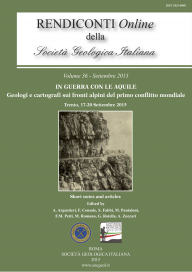
Homo e la spedizione Hoffingott: miniere, guerra e narrazione in Robert Musil. Val del Fersina (Trento), 1915
Alessandro Fontanari (a), Massimo Libardi (b), Flavio Ferrari (c) & Paolo Ferretti (d)
(a) Associazione "Amici della storia" di Pergine, c/o Biblioteca comunale di Civezzano, Via Battisti, 1, 38045 Civezzano, Trento, Italy. E-mail: alessandro.fontanari@biblio.infotn.it
(b) Istituto Culturale Mocheno-Bersntoler Kulturinstitut, 38050 Palai in Bersntol | Palú del Fersina | Palai im Fersental, Trento, Italy.
(c) Ecomuseo Argentario; c/o Biblioteca comunale di Civezzano, Via Battisti, 1, 38045 Civezzano, Trento, Italy.
(d) MUSE – Museo delle Scienze di Trento, Corso del Lavoro e della Scienza, 3, 38123, Trento, Italy.
Volume: 36/2015
Pages: 82-85
Abstract
Robert Musil, one of the major writers of the 20th century European Literature, was an Austrian official during the First World War on the Southern front-line. He stayed in Val del Fersina, NE of Pergine Valsugana (Trento), between May and September 1915. The valley is rich in hydrothermal veins crossing the Pre-Permian Variscan crystalline Basement and the Lower Permian volcanites of the "Gruppo Atesino". The mineralization, containing mixed sulphurs in a gangue of quartz with fluorite, baryte and calcite, was exploited from the Prehistory. The mines had their flourishing period between the end of the 15th and the beginning of the 16th century and were definitively closed in the '60 of the 20th century. This paper focus on the novella Grigia, a short story whose protagonist, the geologist Homo, is involved in the relaunch of the old mines in the valley by the entrepreneur Mozart Amadeo Hoffingott. The research demonstrates that Hoffingott was a real person and Musil was inspired by the renewed interest in the mining industry widespread in the Valsugana between the end of the 19th and the beginning of the 20th century.
Keywords
Get Full Text